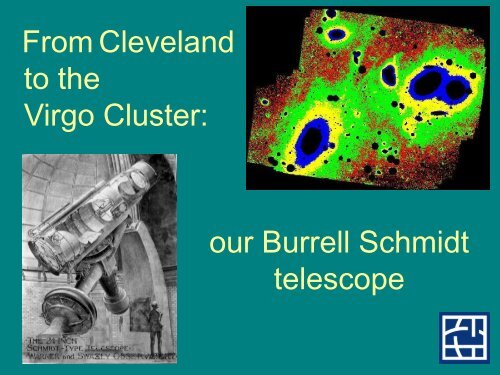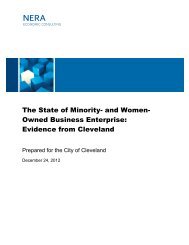Case's Burrell Schmidt telescope - Cleveland.com
Case's Burrell Schmidt telescope - Cleveland.com
Case's Burrell Schmidt telescope - Cleveland.com
Create successful ePaper yourself
Turn your PDF publications into a flip-book with our unique Google optimized e-Paper software.
From <strong>Cleveland</strong><br />
to the<br />
Virgo Cluster:<br />
our <strong>Burrell</strong> <strong>Schmidt</strong><br />
<strong>telescope</strong>
Worcester Warner<br />
(1846-1929)<br />
Ambrose Swasey<br />
(1846-1937)
Warner & Swasey Company<br />
Established a very successful machine tool<br />
business in <strong>Cleveland</strong> in 1881
Amateur astronomers<br />
Professional Telescope Makers<br />
―Mr Warner and I have often been asked if<br />
building astronomical instruments is our<br />
only business, and sometimes I have<br />
answered, ….. that we get our money out<br />
of machinery and our glory out of<br />
<strong>telescope</strong>s.‖<br />
(A. Swasey)
Jan 1888<br />
Lick Obs (CA)<br />
36‖ refractor<br />
Largest <strong>telescope</strong> in the<br />
world at the time
1897<br />
Yerkes Obs (WI)<br />
40 inch refractor<br />
Largest <strong>telescope</strong> in the<br />
world at the time
1919<br />
Victoria BC DAO<br />
72‖ Reflector<br />
Largest <strong>telescope</strong> in the<br />
world for a few months
Warner and Swasey’s<br />
backyard observatory on<br />
Euclid Ave<br />
Built in 1893
The Warner and Swasey<br />
Observatory at Case
Warner &<br />
Swasey gave the<br />
9 ½ inch<br />
<strong>telescope</strong> to<br />
Case in 1919.<br />
Shown at the<br />
observatory at<br />
Taylor Road<br />
Now on A.W.<br />
Smith Building,<br />
Case quad.
Jason Nassau<br />
In 1939 Nassau (the observatory director)<br />
initiated a fund raising campaign to<br />
enlarge the observatory and equip it with a<br />
new <strong>telescope</strong>.<br />
New, exciting design: Wide field <strong>Schmidt</strong><br />
<strong>telescope</strong>
Edward <strong>Burrell</strong> – chief<br />
engineer at Warner and<br />
Swasey -- received a<br />
honorary doctorate from<br />
Case Institute in 1936.<br />
His widow Katherine<br />
made a donation in his<br />
memory for the<br />
<strong>telescope</strong>
<strong>Schmidt</strong> Optics<br />
Wide field <strong>telescope</strong> for surveys<br />
From the 1947 observatory booklet
The optical design of the <strong>Schmidt</strong> was still a novel idea in 1939<br />
In 1931 Bernhard <strong>Schmidt</strong> made the first <strong>telescope</strong> that <strong>com</strong>bined a<br />
mirror and a lens design overcame most optical aberrations.
The Primary Mirror Saga<br />
W&S to Corning upon finding defects in the mirror blank (Oct 7 1940)<br />
―We must tell you that we are not a little concerned with the<br />
results of our inspection‖<br />
Corning reply to W&S (Oct 8)<br />
―We are sorry to learn the 37‖ disk which we shipped you<br />
has not proven altogether satisfactory‖<br />
Corning to W&S (Oct 29)<br />
―Unfortunately, through some unexplainable error in<br />
weighing, ….. resulted in a blank only 6‖ thick……with the<br />
full 37‖ diameter ‖
First home of the <strong>Burrell</strong> <strong>Schmidt</strong><br />
Taylor Rd, East <strong>Cleveland</strong><br />
Now being renovated by Nayyir al Mahdi and Stacey Stoutemire
The <strong>Schmidt</strong> being<br />
installed in its new<br />
dome at the<br />
Warner and Swasey<br />
Observatory.<br />
Taylor Rd
The enlarged observatory and <strong>Burrell</strong> <strong>Schmidt</strong> <strong>telescope</strong><br />
dedicated in 1941 with a meeting of the American<br />
Astronomical Association.
<strong>Burrell</strong> <strong>Schmidt</strong><br />
Telescope<br />
Warner & Swasey<br />
Observatory<br />
Taylor Rd<br />
Nassau & Seyfert (1944)<br />
pointing the <strong>telescope</strong>.<br />
Coordinates are read<br />
from the setting circles.
Nassau &Seyfert (1944)<br />
installing the prism.<br />
With the prism installed<br />
each star’s image is<br />
dispersed, forming a<br />
spectrum (rainbow).
<strong>Burrell</strong> <strong>Schmidt</strong> Prism plate, most of the spectra<br />
in this field are of young stars with strong<br />
hydrogen lines
Case astronomy students circa 1946
Astronomy classes for Case Institute and Western Reserve<br />
students were taught at the Warner & Swasey Observatory<br />
on Taylor Rd (Prof McCuskey, then director)
The move to the Nassau Station<br />
By the mid 1950s city lights had<br />
be<strong>com</strong>e too bright at Taylor Rd<br />
for the type of observations<br />
made by the <strong>Burrell</strong> <strong>Schmidt</strong><br />
The <strong>telescope</strong> was<br />
carefully dismantled…
• Removed from the dome
<strong>Schmidt</strong> <strong>telescope</strong> at Nassau Station, Montville<br />
1957-1978
<strong>Schmidt</strong> Optics Refurbished<br />
In 1978 prior to the move to Kitt Peak the<br />
optics of the <strong>Schmidt</strong> were refurbished by<br />
Perkin-Elmer<br />
Primary mirror refigured to 1/10 th wave<br />
accuracy and a new corrector was<br />
constructed.
The ―Snow-Bird‖ Telescope<br />
Ohio weather, city lights, bad seeing:<br />
needed a better site for <strong>com</strong>petitive<br />
research<br />
Telescope moved to Kitt Peak National<br />
Observatory, W of Tucson, Arizona<br />
Photographic plate replaced by modern<br />
CCD detector (used Newtonian flat)<br />
Much demand for time on <strong>Burrell</strong> <strong>Schmidt</strong><br />
from US astronomical <strong>com</strong>munity
Kitt Peak National Observatory
Working out how to<br />
put the <strong>telescope</strong><br />
back together at<br />
Kitt Peak
The refurbished <strong>Schmidt</strong><br />
at Kitt Peak
Leo<br />
Triplet<br />
Chris Mihos<br />
<strong>Burrell</strong> <strong>Schmidt</strong>
M101<br />
Chris Mihos<br />
<strong>Burrell</strong> <strong>Schmidt</strong>
M13<br />
Chris Mihos<br />
<strong>Burrell</strong> <strong>Schmidt</strong>
Comet Neat<br />
Chris Mihos <strong>Burrell</strong> <strong>Schmidt</strong>
300 Mega<br />
pixel image<br />
M31 (Raja Guhathakurta Lick Observatory)
.<br />
As new astronomers joined the Astronomy<br />
department in recent years—<br />
Heather Morrison, Chris Mihos, Paul Harding<br />
--research with the <strong>Burrell</strong> <strong>Schmidt</strong> <strong>telescope</strong> has<br />
moved from stellar surveys to the study of the<br />
formation of galaxies and clusters of galaxies.
We live in a universe where big objects are<br />
built up from smaller ones<br />
(Mihos, McBride 2004)
Intra Cluster Light<br />
The Virgo cluster is ideal to study with the <strong>Schmidt</strong><br />
• Nearest cluster of galaxies<br />
• Spread over a wide field<br />
• A ―young‖ cluster… still forming
Optimizing the<br />
<strong>Schmidt</strong> for<br />
Ultra-Deep<br />
Imaging<br />
• Needed to make the<br />
optical path as clear<br />
as possible.<br />
• Minimize scattered<br />
light<br />
• Correct optical<br />
problems
Step 1: Weight loss<br />
program<br />
• Removed over 600 lbs of<br />
unneeded ―features‖ on<br />
the <strong>telescope</strong>
*<br />
Step 2: What to do about the Newtonian<br />
• Original Newtonian mirror was<br />
not large enough for the field of<br />
view of our CCD
*<br />
Move the Newtonian further from Primary<br />
• Move of 14 inches towards the<br />
corrector increases Newtonian<br />
apparent size by 2inches in f/3.5<br />
beam<br />
• Have to move the focus to<br />
<strong>com</strong>pensate which means<br />
cutting into the <strong>telescope</strong> tube
Mark out the<br />
hole to be<br />
cut
Time to start cutting
I hope we cut the<br />
hole in the<br />
correct place
All back in<br />
one piece
Detector<br />
back on<br />
the<br />
<strong>telescope</strong><br />
and<br />
working
Deepest image ever of<br />
Virgo Cluster (Mihos et al)<br />
3 dark runs, 6 weeks total observing for 1<br />
image<br />
Image featured in New York Times
Summary and Future<br />
―The little <strong>telescope</strong> that could‖ has been producing<br />
good science since 1941.<br />
Plans for more improvements:<br />
New Newtonian flat this summer<br />
CCD mosiac<br />
Specialized coatings for optics<br />
Warner and Swasey’s legacy continues to this day.
















